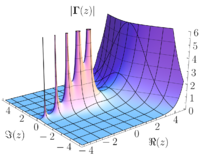Cauchy's integral theorem
| Mathematical analysis → Complex analysis |
| Complex analysis |
|---|
 |
| Complex numbers |
| Complex functions |
| Basic theory |
| Geometric function theory |
| People |
In mathematics, the Cauchy integral theorem (also known as the Cauchy–Goursat theorem) in complex analysis, named after Augustin-Louis Cauchy (and Édouard Goursat), is an important statement about line integrals for holomorphic functions in the complex plane. Essentially, it says that if is holomorphic in a simply connected domain Ω, then for any simply closed contour in Ω, that contour integral is zero.
Statement[edit]
Fundamental theorem for complex line integrals[edit]
If f(z) is a holomorphic function on an open region U, and is a curve in U from to then,
Also, when f(z) has a single-valued antiderivative in an open region U, then the path integral is path independent for all paths in U.
Formulation on simply connected regions[edit]
Let be a simply connected open set, and let be a holomorphic function. Let be a smooth closed curve. Then:
General formulation[edit]
Let be an open set, and let be a holomorphic function. Let be a smooth closed curve. If is homotopic to a constant curve, then:
Main example[edit]
In both cases, it is important to remember that the curve does not surround any "holes" in the domain, or else the theorem does not apply. A famous example is the following curve:
Discussion[edit]
As Édouard Goursat showed, Cauchy's integral theorem can be proven assuming only that the complex derivative exists everywhere in . This is significant because one can then prove Cauchy's integral formula for these functions, and from that deduce these functions are infinitely differentiable.
The condition that be simply connected means that has no "holes" or, in homotopy terms, that the fundamental group of is trivial; for instance, every open disk , for , qualifies. The condition is crucial; consider
One important consequence of the theorem is that path integrals of holomorphic functions on simply connected domains can be computed in a manner familiar from the fundamental theorem of calculus: let be a simply connected open subset of , let be a holomorphic function, and let be a piecewise continuously differentiable path in with start point and end point . If is a complex antiderivative of , then
The Cauchy integral theorem is valid with a weaker hypothesis than given above, e.g. given , a simply connected open subset of , we can weaken the assumptions to being holomorphic on and continuous on and a rectifiable simple loop in .[1]
The Cauchy integral theorem leads to Cauchy's integral formula and the residue theorem.
Proof[edit]
If one assumes that the partial derivatives of a holomorphic function are continuous, the Cauchy integral theorem can be proven as a direct consequence of Green's theorem and the fact that the real and imaginary parts of must satisfy the Cauchy–Riemann equations in the region bounded by , and moreover in the open neighborhood U of this region. Cauchy provided this proof, but it was later proven by Goursat without requiring techniques from vector calculus, or the continuity of partial derivatives.
We can break the integrand , as well as the differential into their real and imaginary components:
In this case we have
By Green's theorem, we may then replace the integrals around the closed contour with an area integral throughout the domain that is enclosed by as follows:
But as the real and imaginary parts of a function holomorphic in the domain , and must satisfy the Cauchy–Riemann equations there:
We therefore find that both integrands (and hence their integrals) are zero
This gives the desired result
See also[edit]
References[edit]
- ^ Walsh, J. L. (1933-05-01). "The Cauchy-Goursat Theorem for Rectifiable Jordan Curves". Proceedings of the National Academy of Sciences. 19 (5): 540–541. doi:10.1073/pnas.19.5.540. ISSN 0027-8424. PMC 1086062. PMID 16587781.
- Kodaira, Kunihiko (2007), Complex Analysis, Cambridge Stud. Adv. Math., 107, CUP, ISBN 978-0-521-80937-5
- Ahlfors, Lars (2000), Complex Analysis, McGraw-Hill series in Mathematics, McGraw-Hill, ISBN 0-07-000657-1
- Lang, Serge (2003), Complex Analysis, Springer Verlag GTM, Springer Verlag
- Rudin, Walter (2000), Real and Complex Analysis, McGraw-Hill series in mathematics, McGraw-Hill
External links[edit]
- "Cauchy integral theorem", Encyclopedia of Mathematics, EMS Press, 2001 [1994]
- Weisstein, Eric W. "Cauchy Integral Theorem". MathWorld.
- Jeremy Orloff, 18.04 Complex Variables with Applications Spring 2018 Massachusetts Institute of Technology: MIT OpenCourseWare Creative Commons.











![{\displaystyle \gamma :[a,b]\to U}](https://wikimedia.org/api/rest_v1/media/math/render/svg/d032547cae79cddd62ad7e267d9073b29a5a89d0)


![{\displaystyle \gamma (t)=e^{it}\quad t\in \left[0,2\pi \right],}](https://wikimedia.org/api/rest_v1/media/math/render/svg/d8c31ef138b7b9684d8d3572b4c0a8bedfeb5dff)







![{\displaystyle \gamma (t)=e^{it}\quad t\in \left[0,2\pi \right]}](https://wikimedia.org/api/rest_v1/media/math/render/svg/2153454b7e40508bc85b3ff455a8c7a63375fab8)




















